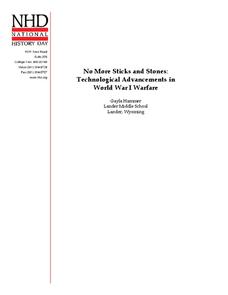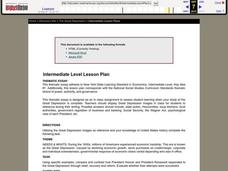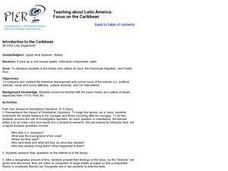Curated OER
Venerable Inventors
Students discuss important historic inventors and read their biographical information. For this world history lesson, students describe Alexander Bell, Thomas Edison, and Guglielmo Marconi using vocabulary terms used in their text....
Curated OER
Westmoreland Trail
Seventh graders complete a unit of lessons on the Westward expansion of the U.S. They play the computer game, Oregon Trail III, read primary source documents, conduct Internet research, write diary entries from the pioneer viewpoint, and...
Curated OER
The Man Who Made the Presidency
High schoolers explore the contributions that George Washington made to the presidency. In this presidential history lesson, students analyze primary and secondary sources regarding Washington and the precedents he set. High schoolers...
Curated OER
Our City, Our Words
Students write poetry that captures their feelings about their city or town. After presenting their poetry at a class reading students compare their poetry to the work of published poets who have written about the same city.
Curated OER
The Changing Landscape
Learners examine the evolution of landscape painting in France from the 17th to the 19th century. They study and compare three landscape paintings, emphasizing space, depth, and the concepts of foreground, middle ground, and background.
Curated OER
Sectionalism and the Kansas-Nebraska Act
Students define and discuss sectionalism and popular sovereignty, analyze impact of popular sovereignty in creation of state of Kansas, compare issues in territorial Kansas to current politically divisive topic, and evaluate primary...
Curated OER
American and Japanese Cities
Learners compare different cities within Japan and within the United States, as well as Japanese and American cities with each other. Students research cities and then write a short essay comparing them.
Curated OER
Universal Traditions
Students research personal bias towards the story Marriage is a Private Affair. In this tradition research lesson, students read the story and discuss the ending. Students free write about the topic and complete a Venn diagram to compare...
Curated OER
Develop Your Own Interpretation
Students use pieces of Andy Warhol's art to write critiques. Using different points of view, they answer discussion questions and share them with the class. They also interpret the art from a historian and artist point of view. They...
Curated OER
Oregon Cities
Students research one 20th century Oregon city, focusing on its population changes and the reasons for the changes. They write an expository essay which includes graphs/charts.
Curated OER
Election 2000
Learners review the 2000 presidential election. Students write an expository essay in response to the following: Should the election process in the United states be changed?
Curated OER
Down in the Dumps
After an introduction to municipal sludge, middle school ecologists consider the pros and cons of dumping in the Hudson River Canyon. The class is split into two groups: one to debate in favor or dumping and one to debate against the...
National History Day
No More Sticks and Stones: Technological Advancements in World War I Warfare
Remind young historians that many technological advancements influenced the events of World War I. After analyzing technology's evolution through primary sources, discussing the changes over time, and watching various video clips,...
Curated OER
Artistic License
Students consider the venues in which they prefer to view art. They research art institutions' efforts to stimulate and fulfill the public's appetite for art, then compare them with similar efforts by commercial venues.
Curated OER
Prized Photos
Learners study World Press Photo prize-winning photos in small groups and compare them with memorable personal photos.
Curated OER
The Great Depression
High schoolers use Using specific examples, compare and contrast how President Hoover and President Roosevelt responded to the Great Depression through relief, recovery and reform. They evaluate whether their attempts were successful.
Curated OER
A Day in the Life
Students write an essay. In this comparison lesson, students read about a child's typical day on a fair trade cocoa farm in the Dominican Republic. Students write about a typical morning of a child in the US and make comparisons.
Curated OER
Migration and Immigration in the United States: Three Case Studies
Students examine the early migration of Native Americans, African Americans, and the British Colonists. They conduct Internet research, complete a timeline, label maps, compare/contrast the three groups' experiences, and write an essay.
Curated OER
Across The Centuries
Students analyze the American Bill of Rights, compare it to the English Bill of Rights and note the differences in an essay. They access websites imbedded in this plan to do their research, then present their findings to the class.
Curated OER
GLOBALIZATION
Students define the concept of the global community. They analyze characteristics of global communities using Stark's three categories: communication, economy, and culture/community. They write a five-paragraph essay which includes an...
Curated OER
Cultural Creation Myths
Students write original plays based on supernatural explanations of existence. In this cultural creation myths lesson, students listen to five different stories about supernatural creation. Students record similarities and differences in...
Curated OER
Pass the Peace Pipe
Students investigate the history of smoking in the United States. In this history of smoking lesson plan, students read about the Native American influence on early settlers before researching the Internet for information about the...
Curated OER
Introduction to the Caribbean
Students examine the history and culture of Cuba, the Dominican Republic, and Puerto Rico. They conduct research on Christopher Columbus, create a quiz, watch a video about Cuba, and write an essay comparing and contrasting Puerto Rico...
Curated OER
SENSORY ELEMENTS
Students describe the sensory elements of musical selections (i.e., tempos, dynamics, and articulations). They write an essay evaluating Saint-Saens' effectiveness in using sensory elements in both selections. They describe the...

























